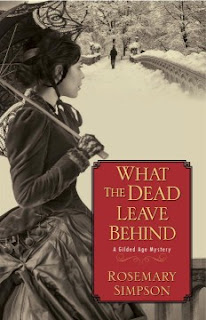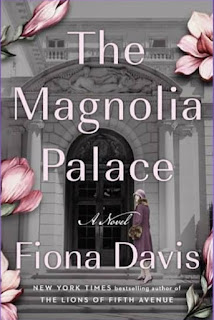Author: Kathleen Marple Kalb
Title: A Fatal Finale
Genre: Mystery (Historical Mystery)
Publication Date: April 28, 2020
Number of Pages: 304
Geographical Setting: New York, New York, USA
Time Period: 1899
Series: Ella Shane Mysteries
Plot Summary:
It’s 1899 in the great city of New York and Ella Shane, who grew up poor in New York’s lower East Side is now an opera diva and owner of her own opera company. Her only problem is that the young woman playing Juliet (her real name was Frances) died on stage a few months ago. While the death is ruled a suicide, Frances' cousin, a duke from England, shows up on Ella’s doorstep wanting to know more about the death. So begins Ella’s exploration into this unusual death.
During her informal investigation Ella uncovers the truth and develops a relationship with the duke that has the town talking. The novel is rich with period descriptions, particularly about the social conventions of the time.
The pace is quite slow and then the mystery is solved quickly right at the end, which was frustrating. But Ella, the duke, and the other characters that inhabit the novel are nicely developed and make the reader ready to read about Ella’s next adventure
Subject Headings:
Mystery – New York, Gilded Age
Mystery – Cozy, Historical
Mystery -- Opera
Appeal:
Tone: “Cozies strike a humorous and gentle note and assure that all will be made right.” (Wyatt & Saricks, 2019, p. 56).
This was a gentle novel, and in fact the reader does not know that murder has happened until the last few chapters. There is mild romantic tension between the duke and Ella, and there are mild social tensions that happen between people of different social classes.
Characterization: “Regardless of how they are drawn, the central protagonists in Mysteries have their sense of honor and justice challenged by the cases they encounter” (Wyatt & Saricks, 2019, p. 53).
Ella clearly is bothered by the question of whether someone killed Frances or she died because of an accidental overdose. Ella also worries that she could have somehow helped Frances more as the young girl tried to develop her career as an opera diva. These are issues of justice and honor and show that Ella is a person of integrity. She cares to see justice meted out.
Frame: “Frame refers to the details and side subjects, as well as the ancillary learning, that are often integrated into a Mystery. Insights into a favorite detective’s hobby or day job, the inclusion of a recipe, or the listing of a lengthy musical playlist are examples of frame details” (Wyatt & Saricks, 2019, p. 55).
The historical details in this novel made the period come to life. The protagonist speaks plainly about attire, and her background as a child of immigrants, and the challenges of being a woman of business in her time period. Issues of motherhood and careers came up, and while those may have been slightly anachronistic it seems reasonable that professional women of the time (and there were professional women then) had these decisions to make.
The author includes details about operas and operatic life, as well as a glimpse into the life of newspaper reporters of the time.
3 terms that best describe this book:
gentle, richly detailed, female amateur detective
Similar Authors and Works:
What the dead leave behind, by Rosemary Simpson
Set in 1888 New York City, an heiress suspects her fiancé was murdered and works with his best friend to find the truth.
Common appeal: strong female amateur sleuth; Gilded Age New York City; richly detailed
A death of no importance, by Mariah Fredericks
This mystery is set in 1910 New York City. A professional housekeeper becomes involved in solving a society murder.
Common appeal: richly detailed, Gilded Age New York (though near the end of that period); independent/professional female amateur sleuth
Deception by gaslight, by Kate Belli
Genevieve Stewart, a woman from a wealthy family, chooses to become a reporter. She becomes involved in finding a jewel thief and murder.
Common appeal: Professional woman as amateur sleuth; Gilded Age New York City; richly detailed
3 Relevant Non-Fiction Works and Authors
Grand opera: the story of the Met, by Charles Affron
This book traces the history of the Metropolitan Opera in New York City since 1883.
Common appeal: history of the opera, divas
Mrs. Astor’s New York: money and social power in a Gilded Age, by Eric Homberger
This book describes New York society during the last part of the Gilded Age (late 1800’s), focusing on Mrs. Astor, who was considered the head of society at that timerou.
Common appeal: New York history, Gilded Age, social expectations
Rogues’ Gallery: the birth of modern policing and organized crime in Gilded Age New York, by John Oliver
This book describes the improvements developed in policing during the Gilded Age in New York. It includes stories of real crimes and criminals as well as policemen.
Common appeal: Gilded Age (history), true crime, society and culture
3 Relevant Fiction Works and Authors (not Mystery genre)
The Magnolia Palace, by Fiona Davis
This novel mixes two time periods (WWI era and the 1960’s) New York, focusing on art and modeling and the Frick family.
Common appeal: Well-developed character, richly detailed writing style, historical period (includes end of Gilded Age)
Carnegie’s Maid, by Marie Benedict
This historical fiction story is set in Andrew Carnegie’s house and times and gives the reader a picture of Carnegie’s life and times, told through the eyes of a fictional maid.
Common appeal: Well-developed character, richly detailed writing style, historical fiction
A beautiful rival: a novel of Helena Rubinstein and Elizabeth Arden, by Gill Paul
This historical novel shares the story of two famous women, how they each succeeded, and how they competed with each other.
Common appeal: richly detailed writing style, well-developed character, professional women in history
References
Wyatt, N. & Saricks, J. G. (2019). The Readers’ Advisory Guide to Genre Fiction (3rd ed.). ALA Editions.











I love cozies! I read a great variety of them. I might have to try this one.
ReplyDelete